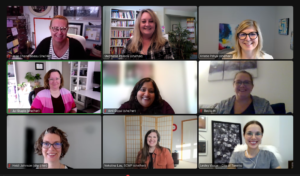*Prefer to listen to me read this post? Click below.
[fusebox_track_player url=”https://traffic.libsyn.com/secure/beyondpro/112_-_Its_not_what_you_say_that_matters.mp3″ title=”It’s not what you say that matters” image=”https://stephaniepollock.com/wp-content/uploads/2022/11/ELSW-Blog-725-x-484-1.png” social_linkedin=”true” social_pinterest=”true” social_email=”true” ]
“What you do speaks so loud that I cannot hear what you say.”
~Emerson
One of the basic tenets of most parenting advice is that kids will do what you do, not what you tell them to do.
If you yell and scream when angry, they’ll be more likely to yell and scream when angry (even when you tell them not to). If you talk about people behind their backs, they’ll be more likely to talk about people behind their backs (even when you tell them not to).
And conversely, if you recover from mistakes and setbacks without berating yourself or others in the process, they’ll be more likely to handle mistakes and setbacks without shame and self-blame.
We know this to be true, whether we’re parents or not.
(and we hate this is true when our kid does something that we KNOW came from us. extra ugh)
What we forget is that it’s just as true at work with our colleagues, team members and clients, as it is at home with our kids.
Yesterday, I held a panel discussion inside LEAD.Well (my leadership community) and invited three members to speak on leading others well.
All three are people leaders:
 – Ami is the Director of Development & Communications at Water First
– Ami is the Director of Development & Communications at Water First
– Nekolina is the Managing Director & Head of Internal Communications at ATB Financial
– Kristie is the Manager, Organizational Wellbeing at Westjet.
These three are thoughtful, empathetic and strong people leaders — with teams from two all the way to 17.
As we talked through some of their lessons learned, and how they navigate hard conversations with employees and what’s needed to create psychologically safe work environments, one of the themes that we came around to numerous times was this:
Show, don’t just tell.
As leaders — whether we lead people directly or not — what we do matters more than what we say to do.
I’m sure you’ve had the experience of a boss, board chair or mentor continue to tell you one thing again and again, only to do the exact opposite. Their requests might come from good intentions, but if the execution of said request isn’t fulfilled, then their words begin to ring hollow.
To be clear, in this context I’m not talking about leaders who are radically disingenuous or actively misleading people, though there are certainly ‘show don’t tell’ examples to be drawn from toxic work environments and leaders.
I’m talking about great everyday leaders who are looking out for everyone else’s interests, thereby often neglecting their own in the process. It’s a tale as old as time.
Raise your hand if you can relate. 🙋♀️ Ya, me too.
As the way we work continues to shift and as much of our human population struggles with burnout and other mental health concerns, many leaders are carrying an extra load right now and doing their very best to keep their teams, projects and priorities afloat.
And with that, comes loose boundaries and a low focus on rest and recovery.
Their intentions are noble of course: they’re priortizing the wellbeing of their teams and people to ensure that the work can continue to get done AND that their people feel taken care of in the process.
Here’s the rub — people don’t do what we say, they do what we do.
And this is especially true when there’s a power differential at play.
If I see my leader work late nights and weekends, all while telling me not to, guess what I’m probably going to do (or feel guilty not doing).
If I see my leader regularly set boundaries and then allow others to break them, guess what I’m going to do the next time someone challenges mine.
And if I see my leader constantly in a state of chaos and overwhelm, all while telling me that it’s no problem to take this Friday off, take a guess as to whether or not I’m going to be in the office on Friday.
We pay attention to what’s on daily display because it tells us what is really valued.
Recently a friend and past client shared with me that she’d had a big, hairy conversation with her team. In it, she drew a firm line in the sand and said, “Enough. We will no longer sacrifice our wellbeing at the request of others. It stops today. And I’m talking as much to me as I am to you.”
And then she committed to me that she wouldn’t touch her work all weekend, despite that nagging to do list she knew was waiting for her.
Because she knew that otherwise, her team would get a very clear message from her of, “Do what I do, not what I say.”
Setting and holding boundaries, taking care of our own needs, and putting the work down is something most leaders struggle with, so you’re not alone if you’re seeing yourself in this letter.
I don’t think we ever get to the other side of it either: the work keeps coming, new projects present themselves, people quit leaving us short support, or a crisis strikes. The workload is always there, demanding our attention.
Our job is to be mindful of when and how we give it, knowing that we always have an audience looking for clues on how to proceed.
What we show matters more than what we tell
In practice, this looks like:
- Modeling back the same behavoiur we expect and ask from others
- Setting firm boundaries to protect our time and wellbeing…and then holding ourselves accountable to them
- Acknowledging when we break our own boundaries and recommitting to upholding them
- Putting our own oxygen mask on first (I know, it’s overused but that’s because it’s true)
- Giving our people permission to call us out when we’re operating in direct contradiction of what we say (this is all predicated on a culture of trust and openness – this isn’t always available to others)
- Getting support if this is too heavy a lift on our own
- And mostly importantly, giving ourselves permission to attend to our own needs, even when the demands of others are at a fever pitch
This is the work of everyday leadership. It’s not sexy, it’s not shiny and it sometimes entirely sucks.
But it’s necessary for the sustainability of your team, your work and mostly importantly, of you.
Steph


